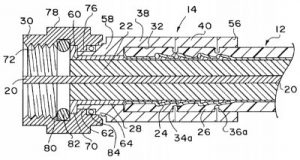 On Tuesday, August 16th, the U.S. Court of Appeals for the Federal Circuit (Fed. Cir.) backed a jury decision made in the patent infringement case PCT International, Inc. v. Holland Electronics, LLC. The Federal Circuit handed down a Rule 36 affirmance in the case that upholds a jury verdict awarded to PCT International, where the patent owner had successfully argued that Holland infringed on a patent it holds in the field of coaxial cable connectors.
On Tuesday, August 16th, the U.S. Court of Appeals for the Federal Circuit (Fed. Cir.) backed a jury decision made in the patent infringement case PCT International, Inc. v. Holland Electronics, LLC. The Federal Circuit handed down a Rule 36 affirmance in the case that upholds a jury verdict awarded to PCT International, where the patent owner had successfully argued that Holland infringed on a patent it holds in the field of coaxial cable connectors.
 The patent-in-suit which PCT International asserted was U.S. Patent No. 6042422, entitled Coaxial Cable End Connector Crimped by Axial Compression. Issued to PCT in March of 2000, it claims a coaxial cable end connector with an outer barrel having a wall with a collapsible band extending between a two non-collapsible wall portions, an inner tube positioned within the bore of the outer barrel and coaxial with the outer barrel and then an annular rib formed by the collapsible band projecting inwards towards the tube when the outer barrel is axially compressed which works to fixedly grip the outer conductor and outer insulation of the coaxial cable. The shallow V-shaped cross section of the collapsible bands enable them to fold without cracking or leaving gaps between non-collapsible portions and also provide a seal preventing moisture from entering conductive pathways.
The patent-in-suit which PCT International asserted was U.S. Patent No. 6042422, entitled Coaxial Cable End Connector Crimped by Axial Compression. Issued to PCT in March of 2000, it claims a coaxial cable end connector with an outer barrel having a wall with a collapsible band extending between a two non-collapsible wall portions, an inner tube positioned within the bore of the outer barrel and coaxial with the outer barrel and then an annular rib formed by the collapsible band projecting inwards towards the tube when the outer barrel is axially compressed which works to fixedly grip the outer conductor and outer insulation of the coaxial cable. The shallow V-shaped cross section of the collapsible bands enable them to fold without cracking or leaving gaps between non-collapsible portions and also provide a seal preventing moisture from entering conductive pathways.
PCT International first filed the infringement suit in August 2012 in the U.S. District Court for the District of Arizona (D. Ariz.). The jury found in favor of PCT, which alleged that a series of 60 coaxial cable connectors being marketed by Holland Electronics infringed upon the ‘442 patent, in September 2015. The damages awarded to PCT exceeded $575,000. PCT also received an order of permanent injunction preventing Holland from any future importation of the infringing products to the United States.
PCT accused Holland of marketing products infringing on the ‘422 patent going back to September 2007, although it was not aware of the infringement until October 2010 when the firm discovered a Holland catalog that listed coaxial cable connectors which PCT believed could infringe upon its technology. Holland’s activities were limited by a 2011 embargo issued by the U.S. International Trade Commission (ITC) but that didn’t stop the infringement fully. The court found against Holland’s contentions that PCT delayed the suit for an “unreasonable and inexcusable length of time” as well as its argument that PCT mislead Holland into believing that the company would not enforce the ‘422 patent. Holland also lost out on an attempt to declare the ‘422 patent as invalid and obvious in view of U.S. Patent No. 5466173, titled Longitudinally Compressible Coaxial Cable Connector and issued in November 1995 to William Down of Phoenix, AZ.
According to Christopher Larus, an IP attorney partner at Robins Kaplan LLP and one of the attorneys representing PCT from the outset of this case, the company was unclear as to whether Holland was actually infringing upon its coaxial cable connector when it discovered the Holland catalog in 2010. The company later obtained samples of Holland’s product and was able to analyze it to determine infringement.
“PCT and Holland are direct competitors,” Larus said. “PCT is making telecommunications products for the last mile, which comes from the pole in a wired system to the home.” Depending on the location, it’s likely that many readers actually use PCT’s coaxial cable technologies as the company sells its products directly to cable and satellite TV providers who then use the coaxial cable connectors when installing systems in residences and elsewhere. “[PCT] might make the product that you see going from your wall junction to the cable box. They might also make the connector for the cable which is buried in the front yard and goes from the telephone pole or green junction box,” Larus said.
One significant aspect of the case was the definition of the term “annular rib” which was raised at trial and on the appeal. During the case’s Markman hearing, Holland did not ask the court to construe the term and relied on the plain and ordinary meaning of the term. According to Webster’s, the definition of annular is “of, relating to, or forming a ring” while one definition for rib is “an elongated ridge.” “Our view from the outset was that Holland’s products satisfied the annular rib under any reasonable interpretation,” Larus said. Later on in the case, Holland presented a construction of “annular rib” which contended that in order for the product to truly be infringing the claim, it must be circular. “After trial, at the charge conference, Holland said it was possible for the court to construe ‘annular rib,’” Larus added. “They offered a partial construction that it was a circular rib but they never addressed the rib.” Holland brought an expert to trial who testified that a rib would have a common, plain and ordinary meaning of a crest or a series of crests.
Although the ruling brought a sizable damages award for PCT, the company is more satisfied with the permanent injunction issued by the court. “A point that I had made throughout this case, which is important to put into context for PCT, was that the company acted promptly upon learning that the products were sold in the U.S. market,” Larus said. “For PCT, the suit was not about collecting past royalties, it was about stopping its competitor from infringing.” Although PCT believes that the testimony presented at trial would have supported a larger verdict but it accepts the jury’s determination on that point.
A lack of written opinion in the Rule 36 affirmance issued by Federal Circuit wasn’t an issue for PCT’s counsel. “These types of results reflect a wholesale rejection of the laundry list of appellate issues Holland had attempted to raise,” Larus noted. “Prompt resolution of this is better than some lengthy opinion that might issue months down the road.” Larus opined that this case represented a success for an innovative company whose success relies on marketing the most innovative products available, noting that there are many challenges to innovative American companies trying to enforce their patents.
Rule 36 affirmances issued by the Federal Circuit have been on the rise in recent years. Data released this June by patent law blog Patently-O indicates that that 43 percent of Federal Circuit decisions appealed from district courts were given a Rule 36 affirmance through the first five months of 2016. This percentage share has risen steadily since 2008, when Rule 36 affirmances were handed down in only 21 percent of district court appeals. For more commentary on Rule 36 see Rule 36 Judgment: The growing problem of one word affirmance by the Federal Circuit.

![[IPWatchdog Logo]](https://ipwatchdog.com/wp-content/themes/IPWatchdog%20-%202023/assets/images/temp/logo-small@2x.png)


![[Advertisement]](https://ipwatchdog.com/wp-content/uploads/2024/04/UnitedLex-May-2-2024-sidebar-700x500-1.jpg)
![[Advertisement]](https://ipwatchdog.com/wp-content/uploads/2024/04/Artificial-Intelligence-2024-REPLAY-sidebar-700x500-corrected.jpg)
![[Advertisement]](https://ipwatchdog.com/wp-content/uploads/2024/04/Patent-Litigation-Masters-2024-sidebar-700x500-1.jpg)

![[Advertisement]](https://ipwatchdog.com/wp-content/uploads/2021/12/WEBINAR-336-x-280-px.png)
![[Advertisement]](https://ipwatchdog.com/wp-content/uploads/2021/12/2021-Patent-Practice-on-Demand-recorded-Feb-2021-336-x-280.jpg)
![[Advertisement]](https://ipwatchdog.com/wp-content/uploads/2021/12/Ad-4-The-Invent-Patent-System™.png)






Join the Discussion
No comments yet.